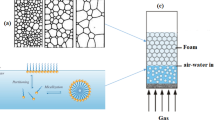Abstract
The influence of processing conditions on the microencapsulation of tilapia oil by spray drying was studied. Trehalose, gelatin, sucrose and xanthan were used as emulsion composition. The experimental parameters of spray drying such as inlet air temperature, solid content, drying air flow rate and atomizing pressure were optimized using a central composite design. Encapsulation efficiency and lipid oxidation were determined. Bulk density, powder morphology and particle size were also analyzed. Trehalose improved the glass transition temperature of wall material significantly and prevented the oxidation of the fish oil. Encapsulation efficiency reached a maximum of 90 % under optimum conditions with an inlet air temperature of 121 °C, a drying air flow rate of 0.65 m3/min and a spray pressure of 100 kPa.



Similar content being viewed by others
References
Aim JH, Kim YP, Lee YM, Seo EM, Lee KW, Kim HS (2008) Optimization of microencapsulation of seed oil by response surface methodology. Food Chem 107(1):98–105
Al-Kahtani HA, Hassan BH (1990) Spray drying of Roselle (Hibiscus sabdariffa L.) extract. J Food Sci 55(4):1073–1076
Bhandari BR, Howes T (1999) Implication of glass transition for the drying and stability of dried foods. J Food Eng 40(1):71–79
Bhandari BR, Datta N, Crooks R, Howes T, Rigby S (1997) A semi-empirical approach to optimise the quantity of drying aids required to spray dry sugar-rich foods. Dry Technol 15(10):2509–2525
Duddu SP, Dal Monte PR (1997) Effect of glass transition temperature on the stability of lyophilized formulations containing a chimeric therapeutic monoclonal antibody. Pharmaceut Res 14(5):591–595
Dziezak JD (1988) Microencapsulation and encapsulated ingredients. Food Technol 42(4):136–139
Gharsallaoui A, Roudaut G, Chambin O, Voilley A, Saurel R (2007) Applications of spray-drying in microencapsulation of food ingredients: An overview. Food Res Int 40(9):1107–1121
Heinzelmann K, Franke K, Velasco J, Marquez-Ruiz G (2000) Microencapsulation of fish oil by freeze-drying techniques and influence of process parameters on oxidative stability during storage. Eur Food Res Technol 211(4):234–239
Hennings C, Kockel TK, Langrish TAG (2001) New measurements of the sticky behavior of skim milk powder. Dry Technol 19(3):471–484
Kagami Y, Sugimura S, Fujishima N, Matsuda K, Kometani T, Matsumura NY (2003) Oxidative stability, structure, and physical characteristics of microcapsules formed by spray drying of fish oil with protein and dextrin wall materials. J Food Sci 68(7):2248–2255
Partanen R, Raula J, Seppänen R, Buchert J, Kauppinen E, Forssell P (2008) Effect of relative humidity on oxidation of flaxseed oil in spray dried whey protein emulsions. J Agr Food Chem 56(14):5717–5722
Roos YH, Karel M (1991) Plasticizing effect of water on thermal behavior and crystallization of amorphous food models. J Food Sci 56(1):38–43
Rosenberg M, Sheu TY (1996) Microencapsulation of volatiles by spray-drying in whey protein-based wall systems. Int Dairy J 6(3):273–284
Sagar VR, Kumar SP (2010) Recent advances in drying and dehydration of fruits and vegetables: a review. J Food Sci Technol 47(1):15–26
Sankarikutty B, Sreekumar MM, Narayanan CS, Mathew AG (1988) Studies on microencapsulation of cardamon oil by spray-drying technique. J Food Sci Technol 25(4):352–356
Serfert Y, Drusch S, Schmidt-Hansberg B, Kind M, Schwarz K (2009) Process engineering parameters and type of n-octenylsuccinate-derivatized starch affect oxidative stability of microencapsulated long chain polyunsaturated fatty acids. J Food Eng 95(3):386–392
Sheu TY, Rosenberg M (1998) Microstructure of microcapsules consisting of whey proteins and carbohydrates. J Food Sci 63(3):491–494
Shibasaki A, Irimoto Y, Kim M, Saito K, Sugita K, Baba T (1999) Selective binding of docosahexaenoic acid ethyl ester to a silver-ion-loaded porous hollow-fiber membrane. J Am Oil Chem Soc 76(7):771–775
Shu B, Yu WL, Zhao YP, Liu XY (2006) Study on microencapsulation of lycopene by spray drying. J Food Eng 76(4):664–669
Siriskar DA, Khedkar GD, Lior D (2011) Production of salted and pressed anchovies (stolephorus sp.) and it’s quality evaluation during storage. J Food Sci Technol. doi:10.1007/s13197-011-0450-9
Thomsen MK, Lauridsen L, Skibsted LH, Risbo J (2005) Temperature effect on lactose crystallization, Maillard reactions, and lipid oxidation in whole milk powder. J Agr Food Chem 53(18):7082–7090
Trindade MA, Grosso CRF (2000) The stability of ascorbic acid microencapsulated in granules of rice starch and in gum arabic. J Microencapsul 17(2):169–176
Truong V, Bhandari RB, Howes T (2005) Optimization of concurrent spray drying process for sugar-rich foods. Part II- Optimization of spray drying process based on glass transition concept. J Food Eng 71(1):66–72
Uauy R, Valenzuela A (2000) Marine oils: the health benefits of n-3 fatty acids. Nutrition 16(7):680–684
Velasco J, Dobarganes C, Marquez-Ruiz G (2003) Variables affecting lipid oxidation in dried microencapsulated oils. Grasas Aceites 54(3):304–314
Wanasundara UN, Shahidi F (1998) Lipase-assisted concentration of n-3 polyunsaturated fatty acids in acylglycerols from marine oils. J Am Oil Chem Soc 75(8):945–951
Acknowledgments
This work was supported by grants from the Ministry of Agriculture of the People’s Republic of China (CARS-49), and National Agriculture Science Technology Achievement Transformation Fund of China (2010GB23260577, 2009GB2E200303, 2010GB2E000335).
Author information
Authors and Affiliations
Corresponding author
Rights and permissions
About this article
Cite this article
Huang, H., Hao, S., Li, L. et al. Influence of emulsion composition and spray-drying conditions on microencapsulation of tilapia oil. J Food Sci Technol 51, 2148–2154 (2014). https://doi.org/10.1007/s13197-012-0711-2
Revised:
Accepted:
Published:
Issue Date:
DOI: https://doi.org/10.1007/s13197-012-0711-2




